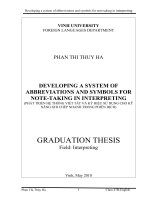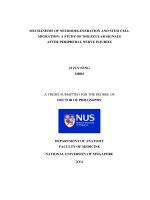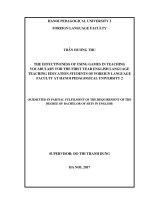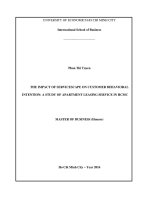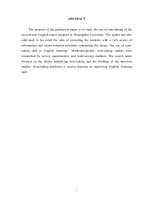- Trang chủ >>
- Cao đẳng - Đại học >>
- Luật
OPTIMIZING EFFECTIVENESS OF NOTE TAKING IN CONSECUTIVE INTERPRETING a STUDY IN LEGAL CONTEXTS
Bạn đang xem bản rút gọn của tài liệu. Xem và tải ngay bản đầy đủ của tài liệu tại đây (1.06 MB, 42 trang )
MINISTRY OF EDUCATION AND TRAINING
HO CHI MINH UNIVERSITY OF LAW
DEPARTMENT OF LEGAL ENGLISH
GRADUATION THESIS
B.A. DEGREE IN ENGLISH
Major: Legal English
OPTIMIZING EFFECTIVENESS OF
NOTE-TAKING IN CONSECUTIVE INTERPRETING
A STUDY IN LEGAL CONTEXTS
Supervisor: LL.M. & M.A. PHAM THI PHUONG ANH
Student: PHAM THI VAN ANH
Student ID: 1652202010009
Class: LE41
Ho Chi Minh City, 2020
ACKNOWLEDGEMENT
First of all, I would like to express my deepest gratitude to my instructor, Mrs.
Phuong Anh Pham for her dedicated guidance on this graduation thesis. She not only
continuously assisted me on developing ideas for this thesis but also recommended
valuable resources for further references. In addition to my instructor, I would like to
thank the Management Board of Legal English Department for giving me a great
chance to make a research on the subject of note-taking in consecutive interpretation.
My sincere thanks also go to KPMG Legal Limited (Vietnam) for offering me
precious internship opportunity in their company, providing me with diverse legal
knowledge and practical experiences, especially through legal translating projects.
Additionally, I would like to thank all the skillful interpreters and also interpreting
students from AKT Company who willingly took part in the survey of this thesis to
help create a more detailed and insightful look on consecutive interpretation in
general and note-taking skill in particular.
Lastly, I would like to involve my beloved family and my friends, who always try to
provide me with the best conditions to complete the project, without their constant
encouragements and supports, this thesis would have never been fulfilled.
LIST OF CONTENTS
INTRODUCTION ..................................................................................................... 1
1. The Background to the Thesis ................................................................................... 1
2. The Significance of the Thesis.................................................................................... 2
3. The Structure of the Thesis ........................................................................................ 2
CHAPTER 1: LITERATURE REVIEW ................................................................ 4
1.1. The importance of Note-taking in Consecutive Interpreting .............................. 4
1.2. Interpreting in legal contexts .................................................................................. 5
1.3. Consecutive Interpretation in legal contexts ......................................................... 6
1.4. Note-taking Process in Consecutive Interpreting ................................................. 7
1.6. What to Note ............................................................................................................. 8
1.6.1. Word meanings .............................................................................................. 8
1.6.2. Conjunctions................................................................................................... 8
1.6.3. Data ................................................................................................................. 9
1.6.4. Verb tenses ...................................................................................................... 9
1.7. How to Note .............................................................................................................. 9
1.7.1. Abbreviations ............................................................................................... 10
1.7.2. Symbols ......................................................................................................... 13
1.8. When to Note .......................................................................................................... 14
CHAPTER 2: METHODOLOGIES AND PROCEDURES ...............................16
2.1. Survey...................................................................................................................... 16
2.1.1. The Objective of the Survey ........................................................................ 16
2.1.2. Methodology of the Survey ......................................................................... 16
2.1.3. Procedure of the Survey .............................................................................. 17
2.2. Interview ................................................................................................................. 17
2.2.1. The Objective of the Interview ................................................................... 17
2.2.2. Methodology of the Interview ..................................................................... 18
2.2.3. Procedure of the Interview.......................................................................... 18
CHAPTER 3: FINDINGS AND RECOMMENDATIONS .................................19
3.1. Findings on the Survey .......................................................................................... 20
3.1.1. The Importance of Note-taking in Consecutive Interpreting .................. 20
3.1.2. Findings on What to Note ........................................................................... 21
3.1.3. Findings on How to Note ............................................................................. 23
3.1.4. Findings on When to Note ........................................................................... 25
3.2. Findings on the Interviews ...................................................................................28
3.2.1. Findings and Recommendations for objective reasons ............................ 28
3.2.2. Findings and Recommendations for subjective reasons .......................... 29
CHAPTER 4: CONCLUSION ...............................................................................33
4.1. Summary ................................................................................................................. 33
4.2. Limitations and Suggestions ................................................................................. 33
REFERENCES.........................................................................................................35
APPENDICES ..........................................................................................................37
INTRODUCTION
1. The Background to the Thesis
It is apparent that many Vietnamese lawyers get used to Vietnamese legal system as
well as perform technical tasks such as interpreting in Vietnamese style. It might be
challenging for them to clearly comprehend documents, contracts, speech, etc. in
another language, such as English. It should be well-noted that in accordance with
Article 70 of the amended Law on Lawyers No. 20/2012/QH13 dated 20 November
2012, issued by the National Assembly, foreign legal practitioners are not allowed to
be in court proceedings in Vietnam. Vietnamese legal practitioners, who has good
command of foreign language, are obviously capable of performing legal
interpretation to ensure communication efficiency. However, it should not be a
reason for them to neglect their main responsibility as the practice of law requires a
great extent of concentration. Thus, this has opened door for interpreters, especially
legal interpreters who possess good knowledge of legal English. Although English is
not the most spoken language natively, but “it has more than three times the number
of non-native speakers than it has natives” – ELT Group, Oxford University. Hence,
it is objective and reasonable for both local and foreign parties to utilize English for
international communication to resolve legal matters.
Apart from basic requirements of language proficiency and culture sensitivity, there
are apparently quite a few skills that need to be mastered for successful interpreting.
One of them is note-taking skill. Note-taking in consecutive interpreting is a skill to
be learned. There is no abstract theory about the skill, but there are a wide range of
practical principles laid down by succeeding generations of consecutive interpreters
over time.
1
The language students will be the targeted audiences who may wish to read a
detailed depiction of some background knowledge about note-taking skill, especially
in legal contexts, and may be eager to understand given viewpoints of senior
interpreters on the skill.
Hence, this thesis will hopefully facilitate Vietnamese interpreters or whoever
chooses to pursue a career as an interpreter when encountering legal seminars or
dispute resolution hearings such as at courts or arbitration centers in the future.
2. The Significance of the Thesis
Court as well as other legal settings constitute a “highly risky” venue for both
foreign and native parties. Miscommunication could lead to destructive
consequences for those who involved in legal matters. Note-taking technique is of
paramount importance to provide accurate and meaningful message. There have
been a variety of articles published in international journals on the study of notetaking technique in particular. However, due to the fact that many of the authors are
linguistics experts and not legal experts, their works generally just basically set the
theoretical background for note-taking skill without integrating with legal
knowledge.
Moreover, unfortunately, there is no information provided in the legal settings,
which is adjacent to Vietnamese legal system as this field is relatively new,
regardless of its urgency for society. As the number of foreign enterprises moving
their factories to Vietnam or those who wish to corporate with Vietnamese
companies under joint-venture scheme are on the rise, hence, there is an emergence
of complex legal matters and many of them require legal interpreting.
3. The Structure of the Thesis
The thesis is divided into three (3) separate chapters:
2
Chapter ONE: Literature review on Note-taking skill in Legal Consecutive
Interpreting
Chapter TWO: Survey on Note-taking skill in Legal Consecutive Interpreting
Chapter THREE: Interview on Problems and Recommendations
The first chapter addresses literature review, which is to thoroughly work on relevant
published works about how to effectively take notes when practicing consecutive
interpreting from English to Vietnamese. It combines both synthesis, summary and
analysis.
The second chapter is a practical analysis drawing on the findings from a survey.
They are expected to verify the theory of note-taking skill mentioned in chapter one.
The last chapter is based on an interview with skilled interpreters to gain an insightful
and objective viewpoint towards the problems when practicing note-taking skill in all
likelihood. There are also precious recommendations with the mission of increasing
the number of qualified interpreters and advance the field of legal interpreting
education. Suggestions for futher study will be presented in the Conclusion.
3
CHAPTER 1: LITERATURE REVIEW
1.1. The importance of Note-taking in Consecutive Interpreting
During the procedure, both short-term memory and notes should be carried out.
While memory is of great importance to interpreters, notes can be of specific
support.
“When engaged in consecutive interpreting, note-taking is a
best practice that significantly improves the interpreter’s
ability to recall details, organize ideas for deep processing
and increase the accuracy, meaning, and effectiveness of an
interpretation in court and legal settings.” (p. 16, NCIEC
2009).
Note-taking helps improve the interpreter’s concentration, relieves the pressure
placed on an interpreter’s working memory and helps to ensure that details are
precise during interpretation. This is critically important for consecutive
interpretation within the court and legal proceedings where testimony becomes or
has the potential to become evidence in a court case. According to Cornell
University, note taking can be very useful for the interpreter working consecutively:
Firstly, notes improve concentration and prevent distraction, thus enhancing the
comprehension of the speech.
Secondly, notes help the interpreter relieve the memory. Although the interpreter
may have a background ideas of a speech, he or she cannot remember every idea in
the speech because short-term memory only keeps information for a limited amount
of time.
4
Thirdly, notes activate the short-term memory of the interpreter with clues,
abbreviations or signals that re-call the whole information of the speech. With notes,
the main ideas and the links among them become easier for the interpreter to
visualize and transfer it into saying.
Last but not least, the writing will eliminiate subjective factors such as accent, style
or external characteristics of the speaker. As a result, interpreters can only stay focus
on the main information instead of being distracted by the such factors.
Literature review is intended not only to demonstrate relevant theory on note-taking
in consecutive interpreting but also to provide insightful evaluation of the real-life
practice. Hence, this chapter explains various aspects related to the topic of notetaking in sequence ranging from large-scale view to close-up view.
1.2. Interpreting in legal contexts
In order to understand the concept of interpreting, it is advisory to draw it to another
activity for which interpreting is often mistaken - translation. A straightforward
explanation of translation given by Catford (1965, p.20), he simply defined
translation as an “operation performed on languages, a process of substituting a text
in one language for a text in another”.
Roderick Jones, a European Union senior conference interpreter, stated that
interpreting is “immediate oral translation” (2002, p.3). Interpreting, just like
translation, is fundamentally the art of re-expressing.
It is obvious that while translation refers to converting a written text from one
language into another, interpreting refers to orally converting method. While a
translator must be a sharp writer and skilled editor, it is crucial for an interpreter to
have extraordinary listening abilities, good memory aided by good note-taking
techniques and excellent time-management.
Interpreting in the legal setting is a long-recognized area of specialization. Russell
5
notes, “There is widespread agreement among experts in the field of interpretation
that the principle of accuracy of courtroom interpretation is extremely important to
the integrity of the legal system and to ensuring non-English speakers have equitable
access to justice” (p. 57).
That means apart from having a background knowledge and understanding of the
entire communicative situation, legal interpreters should also be competent in
appropriate usage within each language, and in managing the cross-cultural speech
when performing in legal seminars or other dispute resolution hearings. Moreover,
further explanation should be added to better the understanding of the target
audience, especially legal terminology.
1.3. Consecutive Interpretation in legal contexts
As far as the classification of interpreting is concerned, Vietnamese people may ask
for clarification between two types of interpreting, consecutive interpretation and
simultaneous interpretation (or conference interpretation). According to Russell, the
main difference between these two methods lies in how the comprehension phase is
separated from the message conversion phase. Simultaneous interpretation occurs
nearly at the same time as the original utterance of a speech; while consecutive
interpretation, with more given time, follows the original speech after one or very
few sentences. In its most general sense, consecutive interpretation is a method of
interpreting in which interpreter starts the interpretation only after the speaker stop
talking, then he or she will listen to the next few sentences and wait for the speaker to
make a pause again to interpret.
Listening to a foreign speaker and interpreting to the target language at the same time
creates difficulty hearing the following message. Especially during interpreting
witness testimony or in the direct and cross-examination of a foreign party, Russell’s
research (2002) showed that consecutive interpretation has fewer error rates when
compared to simultaneous interpretation. Russell notes, “While all aspects of a trial
6
are important, the area of giving direct evidence and the subsequent crossexamination is critical” (p.160). Given that these interpretations play an evidentiary
role in courtroom, increasing accuracy as well as reducing errors. When interpreting
in legal settings involving interactions other than taking a statement or testimony, the
use of consecutive interpreting can still be considered as the most effective method
for achieving a higher degree of precision. These interactions may involve
investigations, attorney-client interviews, interviews of witnesses, mediations,
meetings, etc.
1.4. Note-taking Process in Consecutive Interpreting
In accordance to Rozan’s work on “7 Principles of Note-taking”, the process of
taking-note can be divided into two separate phases. The first phase is listening
during which the interpreter listens to the speech in the source-language and takes
notes; the second phase is reproducing the speech in the target- language speech
from short-term memory and what they have noted.
Phase One - Listening Phase: L (listening) + M (short-term memory) + N (note-taking)
During phase one, the interpreter is asked to listen selectively and actively to the
original speech, after that the short-term memory is utilised to receive the
information and produce the input information either in memory or in notes or both.
It is apparent to state that note-taking is an indispensible part of the first phase.
Phase Two - Reproducing Phase: R (remember) + R (read the notes) + P (produce the
speech in the target language)
In the second phase, the interpreter collects the information from their memory as
well as from the notes, then produces the speech in the target language.
In order to make notes become an effective tool to consecutive interpreting, the
interpreter must answer the three fundamental questions as follows: (i) what to note;
(ii) how to note; and (iii) when to note.
7
1.6. What to Note
It is apparently impossible to jot down every piece of information withdrawn from
the speech due to the lack of time and labor intensive. Instead they are expected to
provide the main ideas crucial to recall the information in the speech.
1.6.1. Word meanings
The first thing needed to take note should be main ideas. The interpreter is required
to gain the targeting and selection skill as well as omit non-contextual words which
are not contributed to the conprehension of the original speech. It also depends on
how interpreter avoid flaws and a laboured interpreting through the notation and restructuring of the ideas.
1.6.2. Conjunctions
The second thing the interpreter should take into consideration are conjunctions.The
ways in which ideas may be connected are (i) the logical consequence such as
accordingly, consequently, hence, as a result, or therefore; (ii) the logical cause
which often goes with with the words due to, as, because, or since; and (iii)
opposition which can be recognised as yet, however, but, or nevertheless.
Some common conjunctions used in note-taking (which can also be found in
Subsection 1.7.1.):
- as
and that is because, this is the reason why, since, given the fact that,
given that; to convey explanation
- tho
although, despite the fact that; to convey opposition
- but
on the other hand, but, however, nevertheless; to convey limitations
8
- if
it is possible that, assuming that, to convey supposition
- as to
as far as A is concerned, on the matter of; to convey reference
- tfe
therefore, one can then conclude; to convey conclusion
1.6.3. Data
Proper names, numbers, lists of items cannot be recalled based on self-deduction
or logical thinking. Interpreter has no choice but noting them down. Therefore, data
like porper names, numbers, list of items are absolutely what interpreter should learn
how to effectively take note during the consecutive interpreting process.
1.6.4. Verb tenses
It is debatable that whether tenses of verbs worth noting down or not. The forms and
tenses of verbs have certain impact on the context of the given information.
According to Jones, “when noting verbs, interpreters should thus take care to note
the tense correctly, and if appropriate the mode, in particular conditional” (p.42).
While some interpreters prefer the notes with as little detail as possible, others prefer
taking advantage of the notes with a lot of detail. Hence, it seems to depend on the
perference made by each individual interpreter under certain contexts, tenses of verbs
could be noted or not.
1.7. How to Note
Apparently, notes that are logically organized help the interpreter avoid confusion
when utilizing them. In this case, abbreviations and symbols are considered to be
perfect tools to save time in the process of interpreting.
The use of symbols and abbreviations should be come naturally and consistent
9
because any new item – either abbreviation or symbol – created during the process of
interpreting may require more attention and even lead to confusion. Hence, only by
developing his or her own system of abbreviations and symbols in advance, can the
interpreter utilize them skillfully.
1.7.1. Abbreviations
There are three rules of abbreviations invented by Rozan: (i) abbreviation of words;
(ii) abbreviation to indicate verb tenses and (iii) abbreviating the expression.
(i) The first rule, “Unless a word is short (4-5 letters), the interpreter should note it
in an abbreviated form” and “write some of the first and last letters rather than
trying to write as many letters as possible from the start onwards” (Rozan, n.d).
For example:
Aff. could be read as “ affirmed” or “affidavit” whilst Affd and Avit are
unambiguous
App. could be read as “appellant” or “appellee” whilst Appnt and Appee are
unambiguous
Con. could be read as “contract” or “conviction” whilst Cotr and Covict are
unambiguous
(ii) The second rule states that “to indicate tense we add
ll
for the future and
d
for
the past” (Rozan, n.d.).
(iii) The third rule is “wherever possible we must abbreviate by using a word which
conveys the same meaning but is much shorter” (Rozan, n.d.). It is applied to
abbreviate long expressions.
For example:
10
“in order to reach some conclusion” can be noted “to end”
“considering the situation at the present time” can be noted “as siton now”
“with the purpose/with the intention” can be noted “to”
The tables below are illustrating some collections of abbreviations which may enhance
the performance of note-taking process in consecutive interpreting.
1. kilometre
km
19. labour
lbr
37. especially
esp.
2. kilowatt
kw
20. people
pp
appr.
3.
kilowatt kwh
hour
4. centimetre
cm
21. society
soc.
38.
approximately
39. according
22. economy
eco.
40. abbreviation
abbr.
5. millimetre
mm
23. monetary
mon
41. example
eg
6. number
no
24. politics
pol
42. television
tv
7. figure
fig.
25. popular
pop
43. dictionary
dic
8. maximum
max
26. export
exp
44. computer
pc
9. minimum
mini
27. import
imp
45. technology
tech
10. hundred
h
28. professional
pro
46. electricity
elec
20. million
mil
29. production
prod
47. defintion
def.
12. thousand
thou
30. department
dep
48. laboratory
lab
13. mathematic math
31. bureau
bu.
49. recreation
rec
14. literature
lit.
32. agriculture
agr
50. university
uni.
15. chemistry
chem
33. industry
indus
51. individual
indiv
16. physics
phys
34. corporation
corp.
53. calculation
cal
17. hour
hr
35. company
com
54. problem
prob
18. Tuesday
Tue.
36. commerce
comm
55. influenza
flu
acc.
Table 1. List of Common-Use Abbreviations
Abbreviation of popular organizations should be memorized by interpreters. It
11
requires a precise interpretation of such important bodies apart from related
background knowledge. The following table contains some common names of
Vietnamese Agencies in abbreviation:
Ministry of Trade
MOTD
Ministry of Justice
MOJ
Ministry of Finance
MOF
Ministry of Industry
MOI
Ministry of Fisheries
MOF
Ministry of Construction
MOC
Ministry of Home Affairs
MOHA
Ministry of Public Health
MOPH
Ministry of Transportation
MOT
Ministry of Foreign Affairs
MOFA
Ministry of National Defense
MOND
Ministry of National Security
MONS
Ministry of Information and Culture
MOIC
Ministry of Education and Training
MOET
Ministry of Science and Technology
MOST
Ministry of Investment and Planning
MOIP
Ministry of Post and Telecommunication
MOPT
Ministry of Labour, Invalids and Social Affairs
MOLISA
Ministry of Agriculture and Rural Development
MOARD
Ministry of Natural Resources and Environment
MONRE
Table 2. List of Names of Vietnamese Agencies in Abbreviation
(Circular No. 03/2009/TT-BNG)
12
1.7.2. Symbols
A "symbol" can be a mark, sign or letter used to denote a concept or a definition.
Symbols are faster and simplier to jot down than words. Symbols need to be prepared
in advance to ensure consistency throughout the interpreting phase.
To completely gain benefit of note-taking technique during providing consecutive
interpreting, the interpreter should develop a system of clear, simple and logical
abbreviations and symbols on his or her own. Followings are certain symbol
examples taken from Interpreter Training Resource.
1. because/ the main reason for/ on account of/ due to/ thanks to/ owing to/
coz
since/as
2. therefore/ consequently/ as a result/ that’s why/ for that reason/ hence/ thus
3. so as to/ in order to/ with the aim of/ with the intention of/ with the purpose
4. however/ nevertheless/ on the other hand/ although/ despite/ conversely
5. in addition/ futhermore/ moreover/ besides/ also/ too/ and
so
to
but/➢
+/ &
Table 3. Symbols for Conjunctions
13
success
trade
problem
politics
repression
democracy
impact
work
country
money
meeting
inflation
industry
continue
deficit
surplu
1.8. When to Note
When to note is a very important and also difficult decision that requires the
interpreter to settle duly and smartly. Interpreters should begin to note as soon as
possible without having to wait for a complete sentence. If he or she waits for a
complete sentence delivered or too long, there is a risk of not being able to take note
what has come earlier.
Hence, the interpreter shall has the ability to “predict” upcoming things. Moreover,
the interpreter is not required to note every piece of information exactly the same
14
sequence as the speaker, so there is no need for the interpreter to wait for a finished
utterance to start noting.
It is also worth minding that the interpreter should stop noting immediately and begin
reproducing ideas right after speakers finish their utterances. If the interpreter is too
contingent on notes, he or she will fail to provide the impromptu interpretation,
which is not recommended.
15
CHAPTER 2: METHODOLOGIES AND PROCEDURES
The precious chapter of the thesis provides an overview of note-taking in consecutive
interpreting in legal contexts, drawing on applicable theories, legal-related examples
and illustrations from linguistics resources. However, the gap between the “theory of
note-taking” and “notes” might be great. In order to bridge the gap, a survey and an
in-depth interview on the practice of note-taking technique has been conducted.
2.1. Survey
Due to the fact that Legal English Department of Ho Chi Minh University of Law
does not offer consecutive interpreting courses besides translating, so the students do
not have a round comprehension about how to deliver an effective interpretation,
entailing the mastery of note-taking technique. The survey is carried out among
members of a private group on Facebook named “Bien Phien Dich Tieng Anh –
Vietnamese Translators and Interpreters”. They are those who have practical
experience in interpreting consecutively. Their responses are mainly based on the
experiences that they have accumulated through 1 to 2 years, averagely.
About 20 members of the group were asked to complete the survey.
2.1.1. The Objective of the Survey
The aim of this quantitative survey is to examine how interpreters acknowledge and
take advantage of the note-taking technique in reality from their own viewpoints and
through their practical experience.
2.1.2. Methodology of the Survey
White states that: “Quantitative research is scientific and objective approach” (2002,
16
p. 24). As aforementioned, the main goal of the study is to record the findings about
interpreters’ personal viewpoint on note-taking. Hence, the methodology of
quantitative best suits the objective of the survey. With this type of research, the
results are given as percentages illustrated by bar charts and pie charts.
A survey is in form of of “Group Administered Questionnaire” . It contains 2
multiple-choice questions and 7 questions made under linear scale where the subject
is given chance to choose what best represents his or her opinion on note-taking
technique.
2.1.3. Procedure of the Survey
There has been a total of 11 responses in the end. They were given 5 minutes to
consider and answer 7 questions. There is a clear introduction to the purpose stated in
the survey, hence, no other further explanation was given out verbally. The sample
questionaire is provided in the appendix at the end of this graduation thesis.
2.2. Interview
Above all, unlike translators, interpreters have to deal with oral message under time
pressure without the opportunity of revising, enhancing or cultivating their
interpretation. For these reasons, consecutive interpreting is considered to be
extremely demanding and challenging profession, especially with technical expertise
– here is legal expertise. In the forthcoming section, an empirical report is presented
based on interview method in order to explore certain challenges and suggestions
which may arise during the interpreting process.
2.2.1. The Objective of the Interview
The aim of the interview is to explore what may be the obstacles to prepare a good
note and also what interpreters would do in some specific situations during the
17
process of taking notes, etc.This research will have a more detailed look into legal
contexts.
2.2.2. Methodology of the Interview
The interview method in this form is understood as the In-depth or Free Interview
Method - one of the qualitative research methods. The most enormous advantage of
this interview method is that the quality of information collected is diverse and
individualized. Regarding qualitative research method in general and in-depth
interview in particular, the number of samples is not a matter of concern, it mainly
focuses on evaluating the quality of the responds, sources of information,…to ensure
such information reliable and specialized enough to break down the nature of the
phenomenom. At the same time, this interview method creates a sense of comfort for
performers
and
interviewees.
Some
of
the
questions
being
conducted:
- What are some difficulties you have encountered during giving interpretations?
- Is there any external factor that affects your ability to take note during giving
interpretations?
- Do you suggest your own measurements to enhance your performance of notetaking?
- Do you suggest your own measurements to tackle issues arising from external
factors?
2.2.3. Procedure of the Interview
This study assembled supports from highly qualified legal interpreters in the
performance of consecutive interpreting in court and legal proceedings.
STEP 1: Concretization
This initial, preparatory step is quite similar to what was presented in the
introduction to the interview. It needs to accurately define the goal of the study, here
18
is to identify problems arising from objective and subjective reasons when
performing a interpretation.
STEP 2: Contact
Further in-depth interviews are also conducted with interpreters who have gained
experience with legal settings: three of my lecturers at Ho Chi Minh University of
Law. The looping technique - developing the additional question from the previous
answer - is also a useful technique to keep the interviewee going “naturally”. Many
researchers value the value of serial questions in the case, and this research is not an
exception.
STEP 3: Analysis
Once the number of answers are sufficient to illustrate the on-going difficulties of
this thesis topic, summary - in form of “quotes” to help finalize the writing process and further discussions - for enhancing such performance - will be presented.
19
CHAPTER 3: FINDINGS AND RECOMMENDATIONS
3.1. Findings on the Survey
All questions are analyzed in terms of: the importance of note-taking technique in
consecutive interpreting, what to note, how to note and when to note.
3.1.1. The Importance of Note-taking in Consecutive Interpreting
In the survey, there is a multiple-choice question designed to find out how the
intrpreters assess the role of note-taking among other factors such as: public
speaking, short-term memory, background knowledge, comprehension ability and
language
fluency.
According to the figures, 27.3% agreed that gaining topic knowledge is the most
basic requirement to enhance the performance of consecutive interpreting. It is
undoubted that having well-prepared technical knowledge will benefit the
interpreters with more accurate, meaningful and effective interpretation. The figures
20
for comprehension ability and short-term memory are at equally 18.2%. Senior
interpreters are highly respected for their amazing memory capacity, regardless of
minor errors which can be made up by background knowledge later on, for being
able to remember and interpret words by words.
Speaking of note-taking skill, it only accounts for 9.1% among mentioned important
skills. Without notes, the interpreter is still capable of providing good interpretation.
Notes can be considered as a sign of weakness. However, interpreters differ
significantly in their ability to remember. For some, notes play an indispensable role.
It is clear that short-term memory and note-taking technique cannot be completely
separated as the skill is of great support to facilitate memory capacity. In fact, as
apprentice interpreters, those with less than 2 years’ experience cannot manage to
completely rely on their short-term memory, they need notes as a supporting tool for
many reasons, as aforementioned in Section 1.4.
3.1.2. Findings on What to Note
Although the matter is very much of personal perspective, as each interpreter has
their own preference on what to note, some principles shown in Chapter 1should be
taken into consideration.
Apart from the need for noting down numbers, proper names, and terminologies that
has been suggested by most experienced interpreters, the answer to whether it is
necessary to jot down tenses of verbs is still debatable.
21
